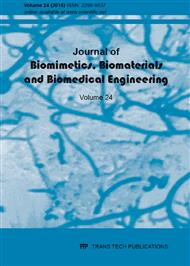[1]
Woodfield, T.B., et al., Polymer scaffolds fabricated with pore-size gradients as a model for studying the zonal organization within tissue-engineered cartilage constructs. Tissue Eng, 2005. 11(9-10): pp.1297-311.
DOI: 10.1089/ten.2005.11.1297
Google Scholar
[2]
Mithoefer, K., et al., Chondral resurfacing of articular cartilage defects in the knee with the microfracture technique. Surgical technique. J Bone Joint Surg Am, 2006. 88 Suppl 1 Pt 2: pp.294-304.
DOI: 10.2106/jbjs.f.00292
Google Scholar
[3]
Brittberg, M., et al., Treatment of deep cartilage defects in the knee with autologous chondrocyte transplantation. N Engl J Med, 1994. 331(14): pp.889-95.
DOI: 10.1056/nejm199410063311401
Google Scholar
[4]
Wong, B.J., et al., Identification of chondrocyte proliferation following laser irradiation, thermal injury, and mechanical trauma. Lasers Surg Med, 2005. 37(1): pp.89-96.
DOI: 10.1002/lsm.20180
Google Scholar
[5]
Bobic, V. and J. Noble, Articular cartilage--to repair or not to repair. J Bone Joint Surg Br, 2000. 82(2): pp.165-6.
DOI: 10.1302/0301-620x.82b2.0820165
Google Scholar
[6]
Lynn, A.K., et al., Repair of defects in articular joints. Prospects for material-based solutions in tissue engineering. J Bone Joint Surg Br, 2004. 86(8): pp.1093-9.
DOI: 10.1302/0301-620x.86b8.15609
Google Scholar
[7]
Redman, S.N., S.F. Oldfield, and C.W. Archer, Current strategies for articular cartilage repair. Eur Cell Mater, 2005. 9: pp.23-32; discussion 23-32.
Google Scholar
[8]
Mow, V.C., A. Ratcliffe, and A.R. Poole, Cartilage and diarthrodial joints as paradigms for hierarchical materials and structures. Biomaterials, 1992. 13(2): pp.67-97.
DOI: 10.1016/0142-9612(92)90001-5
Google Scholar
[9]
Darling, E.M., J.C. Hu, and K.A. Athanasiou, Zonal and topographical differences in articular cartilage gene expression. J Orthop Res, 2004. 22(6): pp.1182-7.
DOI: 10.1016/j.orthres.2004.03.001
Google Scholar
[10]
Aydelotte, M.B., R.R. Greenhill, and K.E. Kuettner, Differences between sub-populations of cultured bovine articular chondrocytes. II. Proteoglycan metabolism. Connect Tissue Res, 1988. 18(3): pp.223-34.
DOI: 10.3109/03008208809016809
Google Scholar
[11]
Hunziker, E.B., T.M. Quinn, and H.J. Hauselmann, Quantitative structural organization of normal adult human articular cartilage. Osteoarthritis Cartilage, 2002. 10(7): pp.564-72.
DOI: 10.1053/joca.2002.0814
Google Scholar
[12]
Otte, P., Basic cell metabolism of articular cartilage. Manometric studies. Z Rheumatol, 1991. 50(5): pp.304-12.
Google Scholar
[13]
Cernanec, J., et al., Influence of hypoxia and reoxygenation on cytokine-induced production of proinflammatory mediators in articular cartilage. Arthritis and rheumatism, 2002. 46(4): pp.968-75.
DOI: 10.1002/art.10213
Google Scholar
[14]
Grimshaw, M.J. and R.M. Mason, Bovine articular chondrocyte function in vitro depends upon oxygen tension. Osteoarthritis and cartilage / OARS, Osteoarthritis Research Society, 2000. 8(5): pp.386-92.
DOI: 10.1053/joca.1999.0314
Google Scholar
[15]
Gibson, J.S., et al., Oxygen and reactive oxygen species in articular cartilage: modulators of ionic homeostasis. Pflugers Archiv : European journal of physiology, 2008. 455(4): pp.563-73.
DOI: 10.1007/s00424-007-0310-7
Google Scholar
[16]
Di Cesare, P.E., et al., Increased degradation and altered tissue distribution of cartilage oligomeric matrix protein in human rheumatoid and osteoarthritic cartilage. J Orthop Res, 1996. 14(6): pp.946-55.
DOI: 10.1002/jor.1100140615
Google Scholar
[17]
Murray, R.C., et al., The distribution of cartilage oligomeric matrix protein (COMP) in equine carpal articular cartilage and its variation with exercise and cartilage deterioration. Vet J, 2001. 162(2): pp.121-8.
DOI: 10.1053/tvjl.2001.0590
Google Scholar
[18]
Leonard, C.M., et al., Abnormal ambient glucose levels inhibit proteoglycan core protein gene expression and reduce proteoglycan accumulation during chondrogenesis: possible mechanism for teratogenic effects of maternal diabetes. Proc Natl Acad Sci U S A, 1989. 86(24): pp.10113-7.
DOI: 10.1073/pnas.86.24.10113
Google Scholar
[19]
Windhaber, R.A., R.J. Wilkins, and D. Meredith, Functional characterisation of glucose transport in bovine articular chondrocytes. Pflugers Arch, 2003. 446(5): pp.572-7.
DOI: 10.1007/s00424-003-1080-5
Google Scholar
[20]
Zhao, K., et al., Effect of glucose availability on glucose transport in bovine mammary epithelial cells. Animal, 2012. 6(3): pp.488-93.
DOI: 10.1017/s1751731111001893
Google Scholar
[21]
Lane, J.M., C.T. Brighton, and B.J. Menkowitz, Anaerobic and aerobic metabolism in articular cartilage. J Rheumatol, 1977. 4(4): pp.334-42.
Google Scholar
[22]
Rajpurohit, R., et al., Adaptation of chondrocytes to low oxygen tension: relationship between hypoxia and cellular metabolism. J Cell Physiol, 1996. 168(2): pp.424-32.
DOI: 10.1002/(sici)1097-4652(199608)168:2<424::aid-jcp21>3.0.co;2-1
Google Scholar
[23]
Ysart, G.E. and R.M. Mason, Responses of articular cartilage explant cultures to different oxygen tensions. Biochim Biophys Acta, 1994. 1221(1): pp.15-20.
DOI: 10.1016/0167-4889(94)90210-0
Google Scholar
[24]
Johnson, W.E., S. Stephan, and S. Roberts, The influence of serum, glucose and oxygen on intervertebral disc cell growth in vitro: implications for degenerative disc disease. Arthritis Res Ther, 2008. 10(2): p. R46.
DOI: 10.1186/ar2405
Google Scholar


